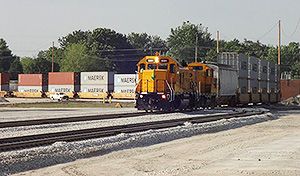More Shipping Through the Mississippi: The Push for Inland Port Development

[Stay on top of transportation news: Get TTNews in your inbox.]
Development and projected growth of inland ports, particularly in the Midwest, is increasingly critical to the nation’s supply chain.

ADM Intermodal Ramp at the Midwest Inland Port. (Midwest Inland Port via YouTube)
“The nation’s inland port system clearly plays a critical role in the global supply chain,” said Mary Lamie, executive director of the St. Louis Regional Freightway, which coordinates regional freight development efforts by connecting the private and public sectors.
An inland port is a rail or a barge terminal connected to a seaport via regular inland transport services — or intermodal hubs. Intermodal operations move cargo in shipping containers by more than one mode — though primarily by rail.
There are an array of logistical activities linked with inland ports, including distribution centers, warehouses and logistical service providers.
The advantage of these hubs, also called “dry” ports, is that more goods get pushed closer to their destination faster.

Ellis
Aaron Ellis, spokesman at the American Association of Port Authorities, said inland ports diminish stress on high-traffic East Coast and West Coast ports.
“The whole purpose of these inland ports is they are developing to serve as a relief valve,” Ellis said. “Ports up and down both the East Coast and the West Coast are creating inland ports to be able to create these efficiencies.”
John Young, surface transportation policy and legislation director for AAPA, said inland ports are also at the crux of developing domestic strategy.

Young
“Our ports identified that 34% of them have working agreements with inland ports. This is a model that is happening throughout the country,” Young said. “It’s about strategic, logistical approaches to moving freight.”
The Midwest agriculture industry is preparing to meet the competitive logistics needs of farmers and the role of local ports by supporting infrastructure investment, experts said.
The inland port strategy is also key in moving domestic goods, especially in the Midwest. For example, Illinois is bordered by the Ohio River on the south, Mississippi River on the west and the Illinois River running right through it.
Scott Sigman, transport and export infrastructure lead for the Illinois Soybean Association, said the web of infrastructure that inland ports create in the Midwest is crucial.
“The primary pathway for soybeans for export starts really on the rivers that surround Illinois, for our 43,000 soy farmers here in the state,” Sigman said. “Sixty percent of our exports are going to the Gulf and about 25 to 30% are going to the Pacific Northwest by rail. So, the inland port network is really critical.”

